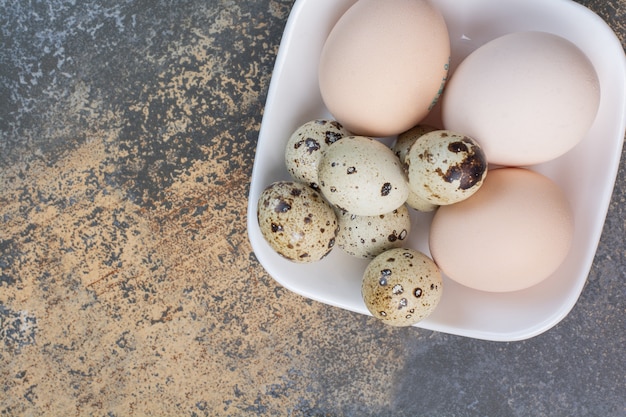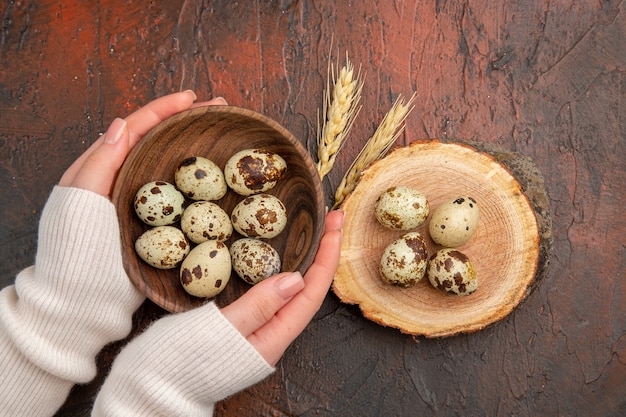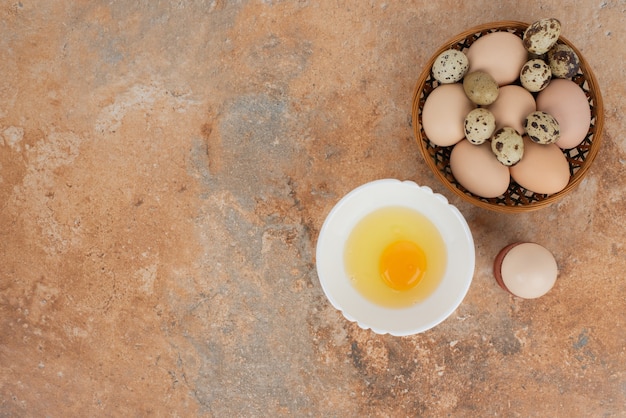Quail eggs are a delightful culinary gem, offering a burst of flavour and a charmingly diminutive size. But when it comes to cooking them, it can be a bit daunting, especially if you're new to these tiny treasures. I remember the first time I attempted to boil quail eggs – I was petrified of overcooking them! But with a little patience and the right information, you can master the art of cooking quail eggs to perfection, achieving the perfect doneness, whether you prefer a soft, creamy yolk or a firm, hard-boiled delight.
In this guide, I'll walk you through the entire process, sharing my personal experiences and tips for achieving a flawless result. We'll cover everything from the basics of boiling to the different levels of doneness, as well as how to cool and peel these delicate little eggs. And just for good measure, I'll throw in some delicious recipe ideas and tackle those common questions that pop up when you're embarking on your quail egg culinary journey.
(Part 1) The Fundamentals of Boiling Quail Eggs

The key to success with quail eggs is understanding that they cook much faster than their larger chicken counterparts. Think of it as a miniature version of the same process, but with a shorter time frame. It's a bit like baking a miniature cake – it takes less time to bake, but you need to be extra vigilant to ensure it doesn't burn!
1.1. The Right Pot and Water
You don't need any fancy equipment. Just a regular saucepan will do. Choose one that's deep enough to comfortably hold the eggs with at least an inch of water covering them. And here's a crucial tip – always start with cold water. Cold water allows the eggs to heat up gradually, ensuring that they cook evenly. Hot water, on the other hand, can lead to uneven cooking, with the outside potentially hardening before the inside has a chance to reach the desired temperature.
1.2. Gently Adding the Eggs
This is where a bit of finesse comes into play. I find it easiest to use a spoon to carefully lower the eggs into the pot, one by one. Avoid dropping them, as this could result in cracks. It's like a tiny egg ballet, gently lowering each precious little egg into the awaiting water bath.
1.3. The Boiling Point
Now comes the exciting part – bringing the water to a boil. Crank up the heat to high and watch as the water starts to bubble and froth. You know it's ready when the bubbles are actively breaking the surface, creating a lively, rolling boil. At this point, the real magic begins – it's time to set the timer and start counting down the seconds!
(Part 2) Timing Perfection: Achieving Different Levels of Doneness

Boiling quail eggs is all about mastering the art of timing. Just like with a good soufflé, it's a precise dance between heat and time, leading to a symphony of flavour and texture. So, how do you know how long to cook them for the level of doneness you're aiming for? Here's a breakdown of the timing for soft-boiled, medium-boiled, and hard-boiled quail eggs, along with insights into the unique characteristics of each:
2.1. Soft Boiled Quail Eggs: Creamy Center, Delicate Delight
There's something magical about sinking your teeth into a soft-boiled quail egg, the yolk still runny and creamy, like a miniature golden treasure. To achieve this delicate texture, boil your quail eggs for just 2 to 3 minutes. The white will be slightly firm, while the yolk will be a luxurious, creamy dream. A perfect choice for breakfast, a light snack, or even a dainty addition to a salad.
2.2. Medium Boiled Quail Eggs: A Touch of Firmness
If you prefer a slightly firmer yolk, without losing the creamy essence, go for medium-boiled. This level of doneness takes just a few extra minutes – 4 to 5 minutes in total. The yolk will still be creamy, but will hold its shape better, making it ideal for chopping into salads or adding to other dishes. It's the perfect compromise between soft and hard, a bit like the Goldilocks of boiled quail eggs.
2.3. Hard Boiled Quail Eggs: The Classic Option for Snacking and More
For those who prefer the traditional, completely solid yolk, aim for hard-boiled quail eggs. They're perfect for snacking on their own, chopping into salads, or creating deviled eggs. Cooking time for this level of doneness is 6 to 8 minutes. You'll end up with a firm, solid yolk and a white that's just as firm, ready for any culinary adventure.
(Part 3) Cooling and Peeling: The Art of Gentle Removal

Once your quail eggs have reached the desired doneness, it's time to cool them down. Cooling helps to stop the cooking process and makes the peeling process much easier, preventing those frustrating moments of shell stubbornly clinging to the delicate egg.
3.1. The Importance of Cooling
Why is cooling so important? Imagine a hot balloon filled with air – as it cools, the air inside contracts, causing the balloon to shrink. The same principle applies to eggs. As the egg cools, the yolk and white contract, creating a space between the shell and the egg, making peeling a breeze.
3.2. Effective Cooling Methods
You have a few options for cooling your boiled quail eggs:
- Ice Water Bath: This is my personal favourite. Fill a bowl with ice water and gently transfer the hot eggs into the icy bath. Let them sit for about 10 minutes until they're completely chilled. The rapid cooling from the ice water makes peeling a breeze.
- Running Cold Water: If you don't have ice on hand, just run cold water over the eggs until they are cool to the touch. This method is slightly less effective than the ice water bath, but it does the job.
- Refrigerator: Place the eggs in a bowl filled with cold water and refrigerate for at least 30 minutes. This is a good option if you're short on time, but it takes a bit longer for the cooling process.
3.3. Mastering the Peeling Process
Peeling quail eggs can be a bit fiddly, but with a gentle touch and a few tips, it's surprisingly easy:
- Gently Tap: Tap the eggs gently on a flat surface to crack the shell. Just a light tap is needed – you don't want to crush the egg! Think of it as a whisper, rather than a shout.
- Start Peeling: Use your fingers to peel away the shell, starting at the wider end of the egg. The shell should come off easily after cooling. If you encounter a stubborn bit of shell, try gently rolling the egg between your hands to loosen it.
- Run Under Water: If you find yourself struggling, run the egg under cold water as you peel. This helps to loosen the shell and makes peeling smoother.
(Part 4) Tips and Tricks for Flawless Quail Eggs
Beyond the basic steps, there are a few additional tips that can make a significant difference in your quail egg cooking journey.
4.1. The Age Factor: Why Older Eggs are Easier to Peel
You might be surprised to learn that older eggs are actually easier to peel than fresh ones. As eggs age, the air pocket inside the egg expands, creating a larger space between the shell and the white. This makes the shell easier to separate from the egg. So, if you're looking for easier peeling, don't be afraid to use older eggs.
4.2. Vinegar: A Debate on its Effectiveness
Many people swear by adding a tablespoon of vinegar to the water when boiling eggs. They claim that it helps to prevent cracking and makes peeling easier. While there's no definitive proof that vinegar makes a significant difference, if you're inclined to try it, go for it. But it's certainly not a necessity.
4.3. Storing Boiled Quail Eggs
To keep your boiled quail eggs fresh and ready for your next culinary creation, store them in the refrigerator in a sealed container filled with cold water. They'll stay fresh for up to a week. This method keeps the eggs hydrated and prevents them from drying out.
(Part 5) Delicious Ways to Enjoy Quail Eggs: Beyond the Basics
Now that you've mastered the art of cooking quail eggs, it's time to unleash your culinary creativity. These tiny eggs offer a multitude of possibilities, both in terms of flavour and presentation.
5.1. A Tiny Treat for Breakfast
Quail eggs are a delightful addition to your breakfast routine. Simply slice them open and enjoy them on toast, or add them to a breakfast salad with avocado, cherry tomatoes, and a sprinkle of fresh herbs. Their delicate flavour complements a variety of breakfast ingredients.
5.2. Adding a Touch of Elegance to Salads
Their diminutive size makes quail eggs a visually appealing and flavourful addition to salads. They provide a boost of protein and a delightful textural element. I love them in salads with mixed greens, roasted vegetables, and a tangy vinaigrette dressing. The contrast between the soft, creamy yolk and the crisp salad ingredients creates a truly delightful dining experience.
5.3. A Quick and Satisfying Snack
Hard-boiled quail eggs make an excellent quick and satisfying snack. They're packed with protein and healthy fats, providing a boost of energy without being overly heavy. Enjoy them on their own or pair them with a small handful of nuts, a piece of fresh fruit, or a dollop of hummus for a more substantial snack.
5.4. Enriching Soups and Stews
Add a touch of elegance and a boost of nutrition to your soups and stews by adding a few quail eggs. They contribute a creamy texture and a subtle flavour that complements many dishes. Think of them as tiny, flavourful pearls adding a touch of magic to your culinary creations.
(Part 6) A nutritional powerhouse in a Tiny Shell
Don't be fooled by their size! Quail eggs are a nutritional powerhouse, offering a wide range of vitamins, minerals, and essential nutrients. Here's a breakdown of some of their most notable benefits:
6.1. Protein Packed: Fueling Your Body
Quail eggs are a great source of protein, essential for building and repairing muscle tissue. They're a perfect fuel source for athletes and anyone looking to boost their protein intake. In fact, quail eggs have a higher protein content per gram than chicken eggs, making them a nutritionally dense option.
6.2. A Rich Source of Vitamins and Minerals
These tiny eggs are packed with a variety of essential vitamins and minerals, including Vitamins A, B, D, and E. They also contain calcium, iron, potassium, and other essential nutrients. These nutrients contribute to overall health and well-being, supporting everything from bone health to immune function.
6.3. Lower in Cholesterol: A Healthier Choice
Compared to chicken eggs, quail eggs contain significantly less cholesterol. This makes them a healthier option for those watching their cholesterol levels. They're a delicious way to enjoy the nutritional benefits of eggs without overdoing it on cholesterol.
6.4. Antioxidant Power: Protecting Your Cells
Quail eggs are rich in antioxidants, which are crucial for protecting your cells from damage caused by free radicals. Antioxidants help to reduce the risk of chronic diseases, including heart disease, cancer, and Alzheimer's disease. They're a delicious way to boost your antioxidant intake and promote overall health.
(Part 7) Are Quail Eggs Safe to Eat? Addressing Salmonella Concerns
You might be wondering about the safety of quail eggs, particularly concerning the potential for salmonella contamination. While it's true that quail eggs can carry salmonella, the risk is actually lower compared to chicken eggs. Here's a closer look at the safety aspects:
7.1. Salmonella Risk: Lower than Chicken Eggs
Quail eggs have a thicker shell and a higher internal temperature, which makes it less likely for salmonella bacteria to penetrate the shell. In addition, quail are more resistant to salmonella infections compared to chickens. This combination of factors contributes to a lower risk of salmonella contamination in quail eggs.
7.2. Cooking Precautions: Essential for All Eggs
The best way to ensure safety is to cook your quail eggs thoroughly. Make sure the yolk is completely solid before consuming them. This is a general safety guideline for all eggs, regardless of their size or origin.
7.3. Buying from Reputable Sources: Ensuring Quality and Safety
Always buy your quail eggs from reputable sources that adhere to strict food safety standards. This ensures that the eggs are handled properly and stored at the correct temperature to minimize the risk of contamination. Look for farms or retailers with good reputations for food safety and freshness.
(Part 8) FAQs about Cooking Quail Eggs
Here are some common questions people have about cooking quail eggs, along with detailed answers:
8.1. How Long Should I Cook Quail Eggs for Deviled Eggs?
For deviled eggs, you want a firm yolk that's easy to scoop out and mash. Cook your quail eggs for 6 to 8 minutes to achieve this level of doneness. Remember to cool them thoroughly before peeling and prepping for deviling. The firm yolk will be perfect for scooping out and creating creamy, flavourful deviled egg delights.
8.2. Can I Cook Quail Eggs in the Microwave?
Yes, you can cook quail eggs in the microwave, but it's important to use a microwave-safe container with a lid. Cook them for 1 to 2 minutes, depending on the power of your microwave. Before microwaving, pierce the yolk of each egg with a toothpick to prevent explosions. This is a quick and convenient method, but for a more consistent result, I prefer the traditional stovetop method.
8.3. What If I Overcook Quail Eggs?
Don't fret! Overcooked quail eggs are still edible, but they won't be as soft and creamy as you might like. They may have a slightly rubbery texture. If you accidentally overcook them, try using them in dishes where the texture isn't as important, such as chopping them into salads or adding them to a hearty stew.
8.4. Can I Freeze Boiled Quail Eggs?
Freezing boiled quail eggs is not recommended. The yolk can become watery and grainy after thawing, impacting the texture and flavour. It's best to enjoy them fresh or store them refrigerated for up to a week for optimal quality.
8.5. Where Can I Buy Quail Eggs?
Quail eggs are becoming increasingly popular, and you can find them in many supermarkets, speciality food stores, farmers' markets, and online retailers. If you have a local farm that sells eggs, they might also offer quail eggs. Don't hesitate to ask around, as quail eggs are becoming more readily available.
And there you have it! A complete guide to cooking quail eggs, from the basics to tips and tricks, and even some delectable recipe ideas. Now, go forth and embrace the charm and culinary delights of these tiny, flavourful treasures. You'll discover a world of delicious possibilities waiting to be explored!
Everyone is watching

Corn on the Cob: The Ultimate Guide to Perfectly Cooked Ears
Healthy MealsAh, corn on the cob. Just the name evokes images of sunny days, barbecues, and that sweet, juicy flavour that ...

Perfect Pork Roast Oven Cooking Time: A Guide to Delicious Results
Healthy MealsThere's something truly satisfying about a perfectly roasted pork. The aroma alone is enough to make your mout...

Ham Cooking Time: How Long to Bake, Smoke, or Boil a Delicious Ham
Healthy MealsAh, ham. It's a classic, isn't it? A real crowd-pleaser, especially around holidays. And when done right, it'...

Scallops: The Ultimate Guide to Perfect Cooking
Healthy MealsAh, scallops. Those delicate, sweet, and utterly delicious morsels of the sea. They hold a special place in my...

Spaghetti Squash: The Ultimate Guide to Cooking and Serving
Healthy MealsRemember that time you saw spaghetti squash at the supermarket, looking all bumpy and strange, and thought, "W...
